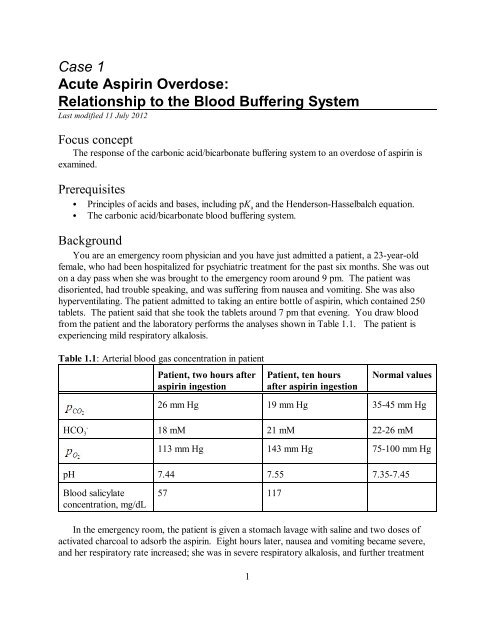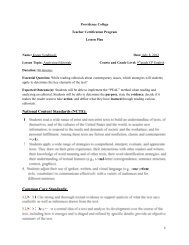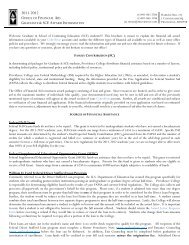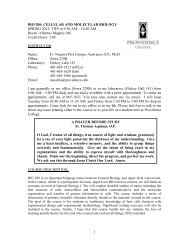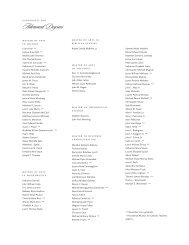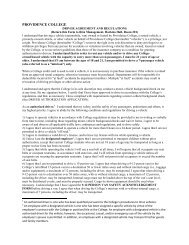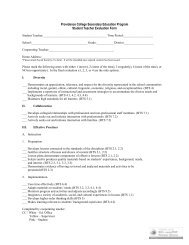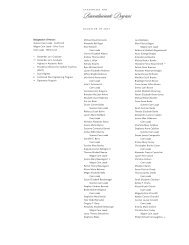Case 1 Acute Aspirin Overdose: Relationship to the Blood Buffering ...
Case 1 Acute Aspirin Overdose: Relationship to the Blood Buffering ...
Case 1 Acute Aspirin Overdose: Relationship to the Blood Buffering ...
You also want an ePaper? Increase the reach of your titles
YUMPU automatically turns print PDFs into web optimized ePapers that Google loves.
<strong>Case</strong> 1<br />
<strong>Acute</strong> <strong>Aspirin</strong> <strong>Overdose</strong>:<br />
<strong>Relationship</strong> <strong>to</strong> <strong>the</strong> <strong>Blood</strong> <strong>Buffering</strong> System<br />
Last modified 11 July 2012<br />
Focus concept<br />
The response of <strong>the</strong> carbonic acid/bicarbonate buffering system <strong>to</strong> an overdose of aspirin is<br />
examined.<br />
Prerequisites<br />
<br />
<br />
Principles of acids and bases, including pK a and <strong>the</strong> Henderson-Hasselbalch equation.<br />
The carbonic acid/bicarbonate blood buffering system.<br />
Background<br />
You are an emergency room physician and you have just admitted a patient, a 23-year-old<br />
female, who had been hospitalized for psychiatric treatment for <strong>the</strong> past six months. She was out<br />
on a day pass when she was brought <strong>to</strong> <strong>the</strong> emergency room around 9 pm. The patient was<br />
disoriented, had trouble speaking, and was suffering from nausea and vomiting. She was also<br />
hyperventilating. The patient admitted <strong>to</strong> taking an entire bottle of aspirin, which contained 250<br />
tablets. The patient said that she <strong>to</strong>ok <strong>the</strong> tablets around 7 pm that evening. You draw blood<br />
from <strong>the</strong> patient and <strong>the</strong> labora<strong>to</strong>ry performs <strong>the</strong> analyses shown in Table 1.1. The patient is<br />
experiencing mild respira<strong>to</strong>ry alkalosis.<br />
Table 1.1: Arterial blood gas concentration in patient<br />
Patient, two hours after<br />
aspirin ingestion<br />
Patient, ten hours<br />
after aspirin ingestion<br />
Normal values<br />
26 mm Hg 19 mm Hg 35-45 mm Hg<br />
-<br />
HCO3<br />
18 mM 21 mM 22-26 mM<br />
113 mm Hg 143 mm Hg 75-100 mm Hg<br />
pH 7.44 7.55 7.35-7.45<br />
<strong>Blood</strong> salicylate<br />
concentration, mg/dL<br />
57 117<br />
In <strong>the</strong> emergency room, <strong>the</strong> patient is given a s<strong>to</strong>mach lavage with saline and two doses of<br />
activated charcoal <strong>to</strong> adsorb <strong>the</strong> aspirin. Eight hours later, nausea and vomiting became severe,<br />
and her respira<strong>to</strong>ry rate increased; she was in severe respira<strong>to</strong>ry alkalosis, and fur<strong>the</strong>r treatment<br />
1
CASE 1 <strong>Acute</strong> <strong>Aspirin</strong> <strong>Overdose</strong>: <strong>Relationship</strong> <strong>to</strong> <strong>the</strong> <strong>Blood</strong> <strong>Buffering</strong> System.<br />
was required. You carry out a gastric lavage at pH = 8.5 and administer fur<strong>the</strong>r activated<br />
charcoal treatments, one every 30 minutes. A bicarbonate drip was required <strong>to</strong> prevent <strong>the</strong> blood<br />
bicarbonate concentration from dropping below 15 mM. After 12 hours, blood salicylate<br />
concentrations began <strong>to</strong> decrease. The patient’s blood pH begins <strong>to</strong> drop around 24 hours after<br />
<strong>the</strong> aspirin ingestion and finally returned <strong>to</strong> normal at 60 hours after <strong>the</strong> ingestion, although<br />
salicylate concentrations did not fall <strong>to</strong> zero until about 80 hours after aspirin ingestion.<br />
Questions<br />
1. <strong>Aspirin</strong>, or acetylsalicylic acid (structure shown in Figure 1.1), is hydrolyzed in <strong>the</strong> presence<br />
of aqueous acid and s<strong>to</strong>mach esterases (which act as catalysts) <strong>to</strong> salicylic acid (<strong>the</strong><br />
pharmacologically active form of <strong>the</strong> drug) and acetic acid. Write <strong>the</strong> balanced chemical<br />
reaction for this<br />
transformation.<br />
Figure 1: Structure of aspirin<br />
2. Since <strong>the</strong> patient was brought in<strong>to</strong> <strong>the</strong> emergency room only two hours after <strong>the</strong> overdose,<br />
you suspect that her s<strong>to</strong>mach might contain undissolved aspirin that is continuing <strong>to</strong> be<br />
absorbed. The fact that she is experiencing severe respira<strong>to</strong>ry alkalosis 10 hours after <strong>the</strong><br />
ingestion confirms your suspicion and you decide <strong>to</strong> use a gastric lavage at pH 8.5 <strong>to</strong><br />
effectively remove any aspirin that still remains in <strong>the</strong> s<strong>to</strong>mach.<br />
a. Calculate <strong>the</strong> percentage of pro<strong>to</strong>nated and unpro<strong>to</strong>nated forms of salicylic acid at <strong>the</strong> pH<br />
of <strong>the</strong> s<strong>to</strong>mach, which is usually around 2.0.<br />
b. Calculate <strong>the</strong> percentage of pro<strong>to</strong>nated and unpro<strong>to</strong>nated forms of salicylic acid at <strong>the</strong> pH<br />
of <strong>the</strong> gastric lavage. How does <strong>the</strong> gastric lavage at pH 8.5 facilitate removal of aspirin<br />
from <strong>the</strong> s<strong>to</strong>mach? Explain. (Note: Assume that <strong>the</strong> pK a values for <strong>the</strong> carboxylate group<br />
in salicylic acid and acetylsalicylic acid are <strong>the</strong> same.)<br />
3. It has been shown that salicylates act directly on <strong>the</strong> nervous system <strong>to</strong> stimulate respiration.<br />
Thus, our patient is hyperventilating due <strong>to</strong> her salicylate overdose.<br />
a. Explain how <strong>the</strong> salicylate-induced hyperventilation leads <strong>to</strong> <strong>the</strong> values of pO 2 and pCO2<br />
symp<strong>to</strong>ms seen in <strong>the</strong> patient.<br />
2
CASE 1 <strong>Acute</strong> <strong>Aspirin</strong> <strong>Overdose</strong>: <strong>Relationship</strong> <strong>to</strong> <strong>the</strong> <strong>Blood</strong> <strong>Buffering</strong> System.<br />
b. Explain how <strong>the</strong> salicylate-induced hyperventilation causes <strong>the</strong> pH of <strong>the</strong> patient’s blood<br />
<strong>to</strong> increase. Illustrate your answer with <strong>the</strong> appropriate equations.<br />
c. Why was <strong>the</strong> bicarbonate drip necessary?<br />
-<br />
4. a. Determine <strong>the</strong> ratio of HCO 3 <strong>to</strong> H2CO 3 in <strong>the</strong> patient’s blood 10 hours after aspirin<br />
-<br />
ingestion. How does this compare <strong>to</strong> <strong>the</strong> ratio of HCO 3 <strong>to</strong> H2CO 3 in normal blood? Can<br />
-<br />
<strong>the</strong> H2CO 3/HCO 3 system work effectively as a buffer in this patient under <strong>the</strong>se<br />
conditions? Explain.<br />
-<br />
b. Compare <strong>the</strong> concentration of HCO 3 in a normal person and in our patient. Then calculate<br />
<strong>the</strong> concentration of H2CO 3 in <strong>the</strong> patient’s blood 10 hours after aspirin ingestion. Again,<br />
compare this value <strong>to</strong> <strong>the</strong> concentration of H2CO 3 found normally, and again address <strong>the</strong><br />
question of buffer effectiveness in <strong>the</strong> patient, but this time, you should use <strong>the</strong> property of<br />
buffer capacity <strong>to</strong> support your answer.<br />
5. Sixty hours after aspirin ingestion, <strong>the</strong> patient’s blood pH returned <strong>to</strong> normal (pH = 7.4). By<br />
what mechanism(s) was <strong>the</strong> patient’s blood pH return <strong>to</strong> normal?<br />
6. Are <strong>the</strong>re o<strong>the</strong>r substances in <strong>the</strong> blood that can serve as buffers?<br />
Reference<br />
Krause, D. S., Wolf, B. A., and Shaw, L. M. (1992) Therapeutic Drug Moni<strong>to</strong>ring 14, pp. 441-<br />
451.<br />
3


